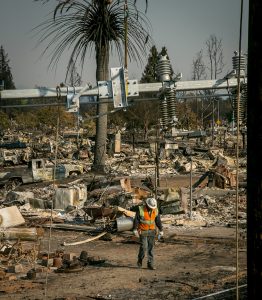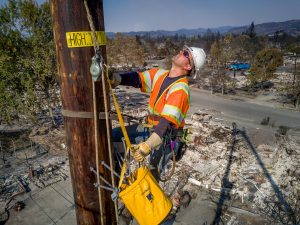In California, autumn is “fire season.” In recent years, our state has seen upward of a dozen fires between August and November, and they generally hit the big forests and other remote, wooded areas with dense foliage.
But the series of wildfires that tore through the North Bay in early October was completely different. The flames hit heavily populated cities and towns, decimating entire communities, taking dozens of lives, and leaving thousands of people without homes – including 29 members of IBEW 1245 (seven members who were evacuated were able to return home this week).
“Absolutely heartbreaking”
Many IBEW 1245 members are accustomed to working in areas hit by fires, but few were prepared for what they encountered in the North Bay.
“It’s absolutely heartbreaking. It almost looks like a war zone,” said Phuong Tran, a PG&E Gas Service Representative out of Oakland. “Entire neighborhoods are wiped out. Parts of the city look like they’ve been shelled. The reports in the media and pictures on TV really do not do it justice, you have to see it for yourself. It’s unbelievably tragic. It’s something I’ll never forget until I leave this world.”
“There are zero houses left here in Coffey Park. When I first saw it, I was in shock, because I grew up in this neighborhood, and I have a lot of friends in this neighborhood that lost their houses,” said PG&E Line Foreman Andy Contreras, a Santa Rosa native who now works out of Lakeville. “I’ve seen stuff like this after the Valley Fire, but this is different because it hit a lot more homes, and because I know people here.”
“I had to tell him his house was gone”
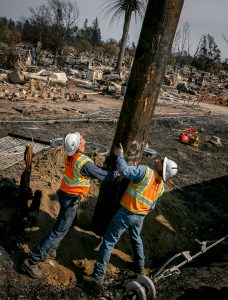 The smoke was still heavy in the air when the Utility Reporter caught up with Contreras and his crew as they were working near the train tracks in the residential area of Santa Rosa that was hit hardest by the Tubbs Fire.
The smoke was still heavy in the air when the Utility Reporter caught up with Contreras and his crew as they were working near the train tracks in the residential area of Santa Rosa that was hit hardest by the Tubbs Fire.
“That house right there was my friend’s house,” Contreras said, gesturing to large pile of ashes and rubble. “I had to call him up at 4am to tell him his house was gone.”
For Contreras and the other members with close ties to the community, working to restore power to the area was an experience rife with emotion. But with so much work to do, there was little time to mourn. Amid the devastating scene, Contreras and his crew worked diligently to replace some of the 1,500 utility poles that were damaged or destroyed by the fire. On this particular day, the crew was replacing two poles adjacent to the train tracks on the Fulton-Santa Rosa #2 line.
To ensure that everyone stayed safe while working in the train’s right-of-way, Contreras had to be in close contact with the Sonoma-Marin Area Rail Transit (SMART) train operators. And the trains were far from the only safety-related challenges they encountered.
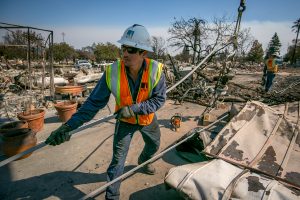 “There’s a lot of burnt debris, burnt poles, broken wire … and then there’s the [residents who were evacuated] coming back in and looking at their houses,” noted Contreras.
“There’s a lot of burnt debris, burnt poles, broken wire … and then there’s the [residents who were evacuated] coming back in and looking at their houses,” noted Contreras.
The fires made for extremely limited road and aerial access, and PG&E needed express permission from CALFIRE before accessing each neighborhood. Completing the work safely was the primary goal for all of the crews, and close attention was paid to every potential safety issue, be it minor or major.
“A lot of respect and gratitude”
In an area of Santa Rosa where some homes were still standing, Gas Service Rep Phuong Tran prepared to begin his work day, with a queue of more than 40 customers waiting for his help. Tran had spent a few days working in Napa at the scene of the Atlas fire before heading to Santa Rosa.
“The days are really long, but I try and keep a positive attitude about it,” said Tran. “The community is really strong and helpful, and the people have been so kind under extremely tough circumstances. They’ve treated all of us GSRs with a lot of respect and gratitude. When they see me, they’re so grateful, since some of them haven’t had hot water or hot shower for four or five days.”
Gas service work in the fire zones is a time-consuming, safety-oriented process. First, PG&E must shut off the gas in the affected areas. Then, all the necessary repairs are made, and everything is double-checked to ensure there are no leaks. Once it has been deemed safe, the final step is to re-light each home, one at a time.
“The customer has to be home for us to re-light, so I get to see every customer face-to-face. I hear their stories, I see the sadness,” said Tran. “I’m there to do my job, but also I try be a good person, understanding that these people have been through a lot. I tell them, ‘Things will be ok, this is the easy part. You guys have already been through the hard part.’ It’s not like it’s my job to make them feel better, but we’re all human beings.”
“Some sort of normalcy”
 The fires left 359,000 customers without power and 9,100 customers without gas, and crews were called in from all across the state to assist. But despite the hefty work load, long hours and challenging conditions, most of the members were grateful to be part of the restoration process.
The fires left 359,000 customers without power and 9,100 customers without gas, and crews were called in from all across the state to assist. But despite the hefty work load, long hours and challenging conditions, most of the members were grateful to be part of the restoration process.
“It’s almost an honor that I get to be here, to help put things back together, but it’s devastating at the same time, because these are my friends’ houses, their lives,” said Contreras.
“These people have been through a lot, I just want to do my part for them,” said Tran. “Things will probably never be ‘normal’ here, but we’re just trying to bring some sort of normalcy, and make their day a little bit better.”
IBEW Local 1245 has taken up a collection for our members whose homes and possessions were taken from them by the fires. The union hopes to give these brothers and sister a bit of financial support as they begin the long and arduous process of rebuilding their homes and lives. To contribute, please visit https://www.gofundme.com/ibew-1245-wildfire-relief-fund.
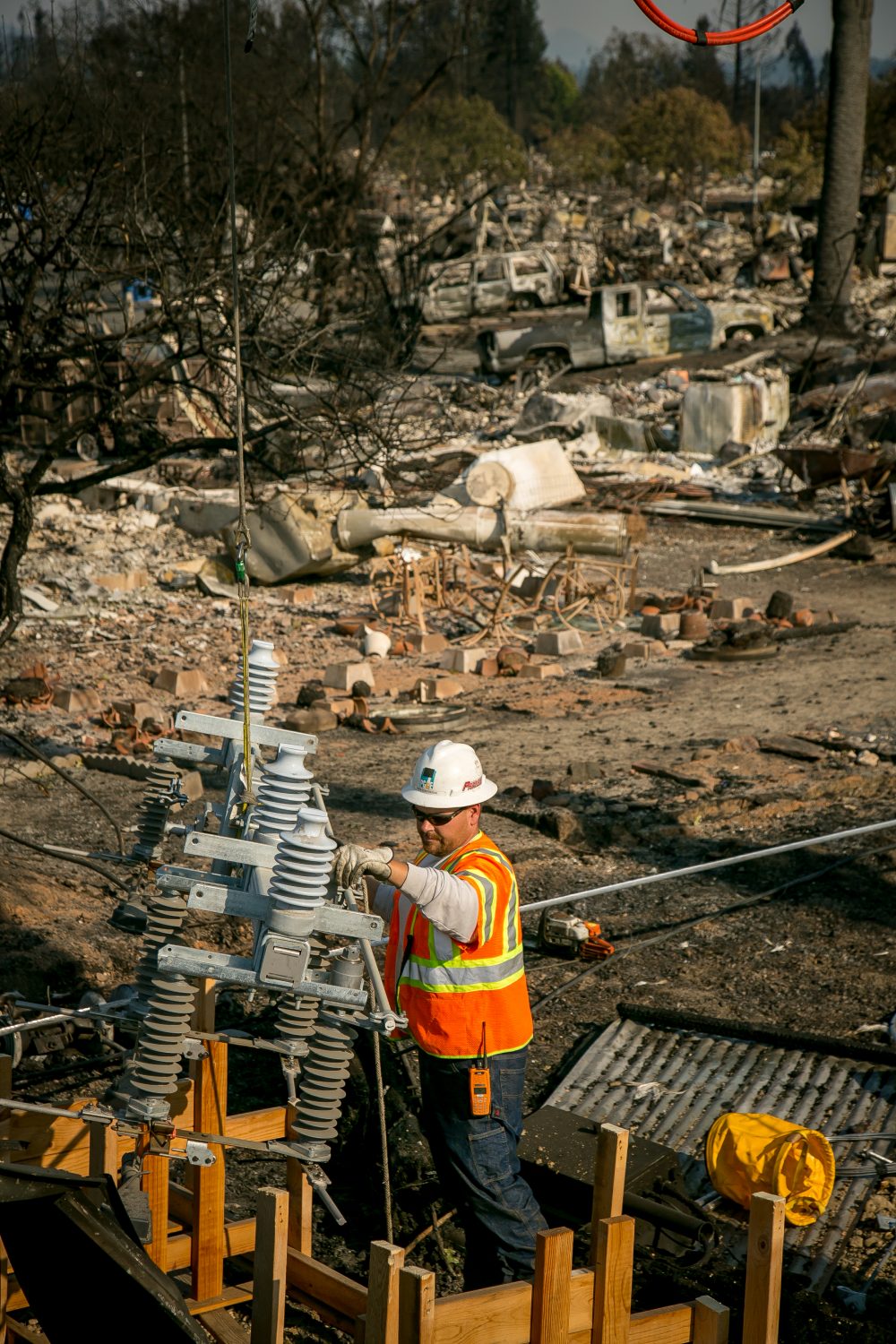
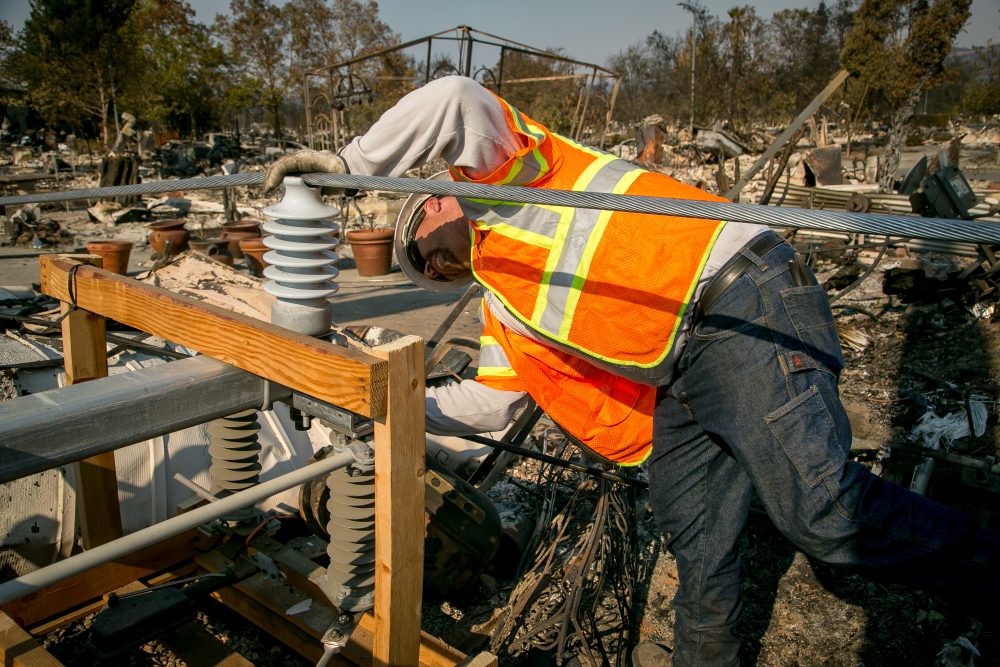









–Rebecca Band, IBEW 1245 Communications Director
Photos by John Storey and Phuong Tran
